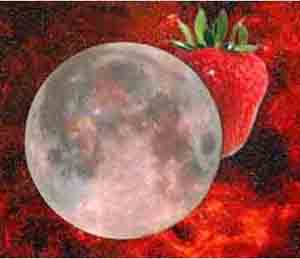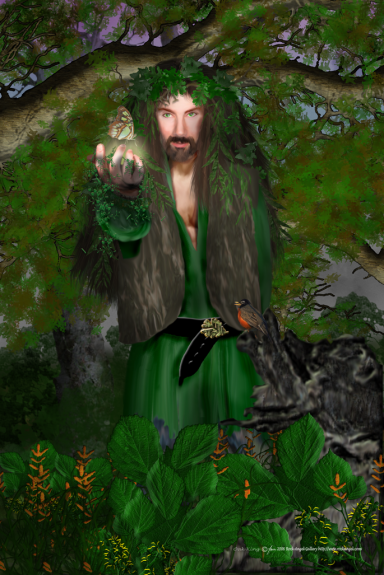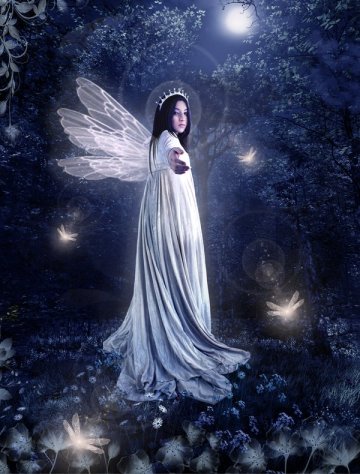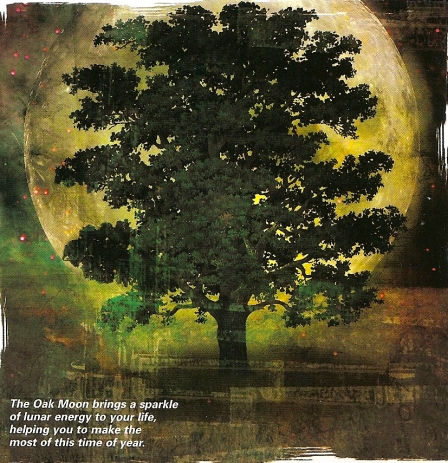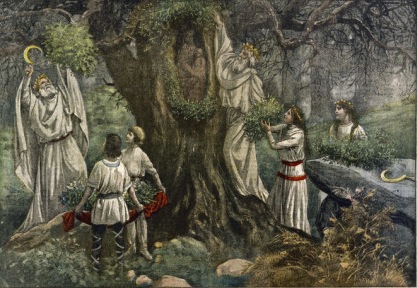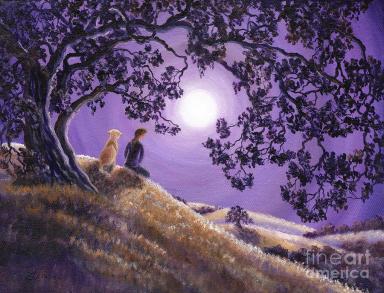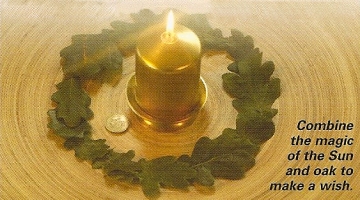
“Athena” by InertiaK
“Athena’s themes are protection, victory, courage and leadership. Her symbols are new clothing, olives, owls and the oak. Among the Greeks, especially those dwelling in Athens, Athena was the great protectress, standing for personal discipline and prowess, especially in battles. When you find your self-control lacking or you need the courage to withstand a storm, Athena stands ready to come to the rescue. Grecian art shows Athena bearing a spear, wearing a breastplate and accompanied by an owl. She is also the patroness of spinners and many other forms of craftspeople who work with their hands.
The Greeks celebrated this Goddess by giving Her a new wardrobe today, making offerings and taking Her images out for cleansing. So, if you have any likeness of the Goddess, dust them off and adorn them in some way, perhaps using an oak leaf for a dress to honor Athena.
Wearing a new piece of splendid clothing or adding olives to your diet today draws Athena’s attributes into your life. Or, use pitted olives as a spell component. On a small piece of paper, write the word that best describes what you need from Athena. Stuff this into the olive and bury it. By the time the olive decomposes, your desire should be showing signs of manifestation.
Finally, place a small piece of oak leaf in your shoe today so Athena’s leadership and bravery will walk with you, helping you to face whatever awaits with a strong heart.”
(Patricia Telesco, “365 Goddess: a daily guide to the magic and inspiration of the goddess”.)

“Athena” by Howard David Johnson
Patricia Monaghan provides us with some very interesting information (some of which is new to me). She says, “[Athena] was not always accepted as patron of the famous city that bears Her name. Greek legend says that the sea god, Posidon, disputed with the Goddess for rulership of the city. It came to a vote of the people of the town in question. The citizens, men and women alike, gathered and cast their ballots. Naturally, the men voted for the god, the women for the Goddess. As it happened, there was one more voter on the women’s side, and so Athena won the day. (An alternate version says that the Olympian deities judged the contest. They ruled that because Athena had planted the first olive tree, whereas all Poseidon could offer was the changeful sea, the Goddess would be a better city ruler than the god).

“Athena & Poseidon” by Rachael McCampbell
The men of Athens bitterly agreed to accept the Goddess as their patron. But being poor losers, they levied three heavy requirements on the women: that they should forgo being called citizens, that they should no longer vote, and that their children should be called by their fathers’ rather than their mothers’ names.
They then prepared a new identity for the city’s Goddess. They claimed that She was a virginal Goddess without sexuality, a motherless Goddess who sprang full-grown from the head of Zeus, who had swallowed Her mother, Metis. This Athena was ‘all for the father’ (as Aeschylus had Her say), who voted on the side of the new patriarchal order against the earlier system of mother right. But hidden in the legend of the Athenian vote are clues to Athena’s original identity. If children did not bear their mothers’ names, if women were not full citizens, if women did not vote, why bother to legislate against it? [Makes you think about what’s going on in today’s political arena here in the US, doesn’t it?]

“Athena” by Hrana Janto
There was yet another version of the birth of Athena [which is completely new to me], one that is far less flattering to male divinity. This story says that She was the daughter of Pallas, a winged giant. He tried to rape his virginal daughter, so She killed him. She tanned his skin to make a shield and cut off his wings to fasten to Her feet. Another myth in which virginity is threatened says that Hephaestus, the smith god, attempted to rape Her, but only managed to ejaculate on Her leg. The Goddess wiped it off in disgust. But the semen touched all-fertile Gaia, whereupon a half-serpent boy named Erichthonius was born. Athena accepted the boy as Her offspring and gave him to the Augralids to guard.
A curious part of this relatively obscure story is the shaky nature of the boy. As Hephaestus had no known reptile ancestors, it must be that Athena provided the serpent blood. Her intimate connection with Medusa, whose snake-haired visage Athena wears on Her goat-skin cloak called the aegis, is also relevant. Similarly, the massive snake that reared beside Her statue in the Parthenon, Her major temple on the Athenian Acropolis, suggests that the snake was one of the primary symbols of the virgin Goddess.

“Snake Goddess” by Pamela Matthews
It is now well established that Athena–Her name is so ancient that it has never been translated–was originally a Minoan or Mycdenaean household Goddess–possibly related to the bare-breasted Cretan figures seen embracing snakes or holding them overhead. This original Athena was the essence of the family bond, symbolized by the home and its hearth–and by the mild serpent, who– like the household cat, lived in the storehouse and protected the family’s food supplies against destructive rodents. As household Goddess, Athena ruled the implements of domestic crafts: the spindle, the pot, and the loom. By extrapolation, She was the guardian of the ruler’s home, the Goddess of the palace; by further extrapolation, She was the symbol of the community itself, the larger social unit based on countless homes [much like Minerva‘s origins if you recall].
Although Minoan civilization declined, Athena was not lost. A maiden Goddess, apparently called Pallas, arrived with the Greeks; She was a warrior, a kind of Valkyrie, a protector of the tribe. This figure was bonded to that of the indigenous tribal symbol to form Pallas Athena, and Her legend was re-created to suit the new social order. But Athena’s ritual reflected Her origins. Each year midsummer Her splendid image was taken from her temple on the Acropolis and borne ceremoniously down to the sea. There Athena was carefully washed and, renewed in strength and purity, was decked in a newly made robe woven by the city’s best craftswomen. It was the same ritual that honored Hera and showed Athena as a woman’s deity–the mistress of household industry and family unity” (p. 59 – 60).

Pallas Athene, 1898, Historisches Museum der Stadt Wien, Vienna
Thalia Took explains that “Athene was probably originally a Goddess of lightning and storms, hence the spear (representing the lightning) and Her famous brilliant eyes, which earned Her the epithet Oxyderkes, the Bright-Eyed. Birds as creatures of the air are Hers as well, especially the owl, with its bright eyes and reputation for wisdom [see Athena Glaukopis].
Athena can be summed up in one word: ability. That ability encompasses just about everything: wisdom, war, weaving, shipbuilding, dance, athletics, music, invention, crafts, and technology in general. Athene brings strength and wisdom, and aid in determining the best course–consult Her in a situation when you are not sure whether to use diplomacy or if the time has come to fight.
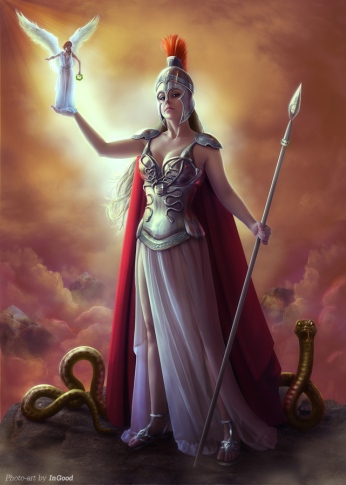
“Athena” by Green–Cat
Some of Her epithets include: Polias (‘of the City’), Parthenos (‘Virgin’), Promachos (‘Champion’), Ergane (‘Worker’), and Nike (‘Victory’).
Athena has many, many epithets and aspects. Articles marked with an * have illustrations, by me (and you can reasonably expect some more, since, as I’ve said, I’m on a wicked Athena kick lately). Here we go:
Aeantis, Aethyia, Ageleia, Agoraea, Agripha, Akraia, Akria, Alalkomeneis, Alea, Alkimakhe, Amboulias, Anemotis, Apatouria, Areia, Asia, Axiopoinos, Boarmia, Boulaia, Contriver, Damasippos, Dea Soteira, Ergane, Erysiptolis, Glaukopis*, Gorgopis, Hephaistia, Hippia, Hippolaitis, Hygieia, Itonia, Keleuthea, Khalinitis, Khalkeia, Kissaea, Kledoukhos, Koria, Koryphasia, Kranaia, Kydonian, Kyparissa, Laossoos, Laphria, Larisaea, Leitis, Lemnia, Mekhanitis, Metros, Narkaea, Nike, Nikephoros, Onga, Ophthalmitis, Optiletis, Oxyderkes, Paeonia, Pallas, Panakhaia, Pania, Pareia, Parthenos, Phratria, Polias, Poliatas, Polyboulos, Polymetis, Poliykhos, Promakhorma, Promakhos, Pronaia, Pronoia, Pylaitis, Saitis, Salpinx, Skira, Sthenias, Soteira, Souniados, Taurobolos, Telkhinia, Tithrones, Tritogeneia, Xenia, Zosteria
Note on the spelling: I have kicked all the C’s (a Latin convention) out of the spelling, since they didn’t exist in Greek, even to replacing ‘ch’ with ‘kh’.” [1] [2]

“Athena” by louelio
ASSOCIATIONS:
General: Sun, golden shield and helmet, spear, spindle, bowl, intertwined snakes, the Parthenon, the seven auras, and the number 7.
Animals: Owl (wisdom), dove (victory), ram, eagle, tiger, leopard, and other cats.
Plants: Geranium, tiger lily, oak, cypress, olive tree, Hellebore (Christmas and Lenten roses), and citrus trees.
Perfumes/Scents: Patchouli, dragon’s blood, musk, indigo, orange blossom, cinnamon, and cedarwood.
Gems and Metals: Onyx, ruby, star sapphire, turquoise, gold, lapis lazuli, and ivory.
Colors: Gold, orange, yellow, emerald green, and royal blue. [3]
Sources:
Goddessgift.com, “Goddess Symbols: Athena“.
Monaghan, Patricia. The New Book of Goddesses and Heroines, “Athena”.
Took, Thalia. A-Muse-ing Grace Gallery, “Athene“.
Took, Thalia. The Obscure Goddess Online Directory, “Athena“.
Suggested Links:
Aethyia. Order of the White Moon, “Athena“.
ancientgreece.com, “Athena – Ancient Greek Goddess“.
The Shrine of the Goddess Athena.
Goddessgift.com, “Athena, Greek Goddess of Wisdom“.
Revel, Anita. igoddess.com, “Athena: firm but fair – goddess of war and diplomacy“.
Stebbins, Elinor. Sweet Briar College {History of Art Program}, “Athena, Goddess of Wisdom“.
Took, Thalia. The Obscure Goddess Online Directory, “Athena Glaukopis“.
Theoi Greek Mythology, “Athene“.
Wikipedia, “Athena“.

